MMK101 T1 2018: Sushi Sushi's Marketing Strategy Assessment 2
VerifiedAdded on 2023/06/12
|8
|2035
|143
Report
AI Summary
This report provides a detailed marketing strategy for Sushi Sushi, focusing on a new target market of health-conscious consumers. It highlights the importance of adapting the marketing mix to cater to this segment. The product strategy emphasizes healthier menu options, maintaining hygiene, and providing detailed nutritional information. Promotional strategies include digital marketing, social media engagement, billboards, and relationship marketing with gyms and health centers. The report also recommends a price skimming strategy to establish a premium brand positioning. The conclusion underscores the potential implications of these strategies, including increased reach, stable positioning, and revenue growth. This assessment is for MMK101 Trimester 1 2018.

[BRAND]
ASSESSMENT 2
MMK101 TRIMESTER 1
2018
MARKETING STRATEGY
\
Student Name:
ASSESSMENT 2
MMK101 TRIMESTER 1
2018
MARKETING STRATEGY
\
Student Name:
Paraphrase This Document
Need a fresh take? Get an instant paraphrase of this document with our AI Paraphraser
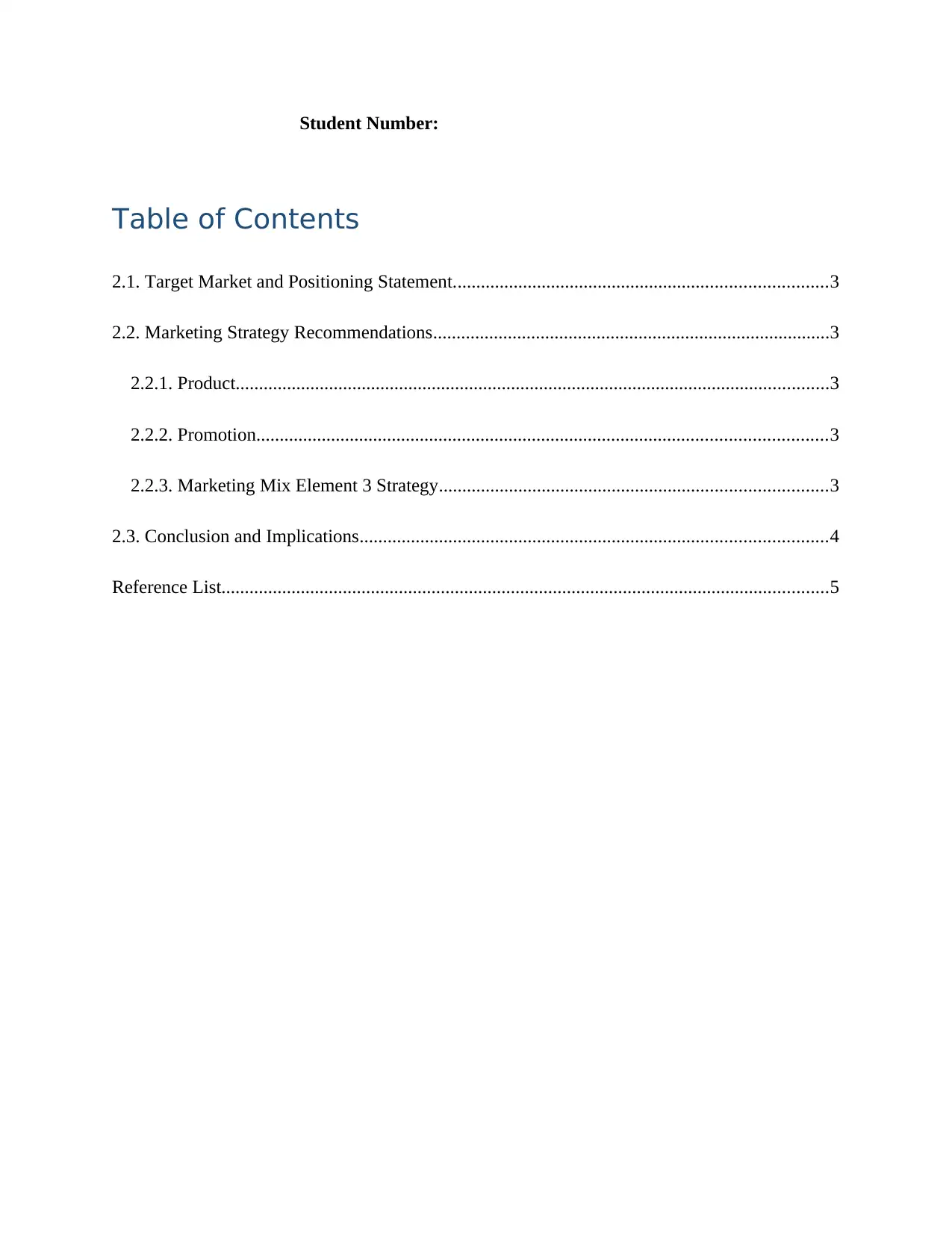
Student Number:
Table of Contents
2.1. Target Market and Positioning Statement................................................................................3
2.2. Marketing Strategy Recommendations.....................................................................................3
2.2.1. Product...............................................................................................................................3
2.2.2. Promotion..........................................................................................................................3
2.2.3. Marketing Mix Element 3 Strategy...................................................................................3
2.3. Conclusion and Implications....................................................................................................4
Reference List..................................................................................................................................5
Table of Contents
2.1. Target Market and Positioning Statement................................................................................3
2.2. Marketing Strategy Recommendations.....................................................................................3
2.2.1. Product...............................................................................................................................3
2.2.2. Promotion..........................................................................................................................3
2.2.3. Marketing Mix Element 3 Strategy...................................................................................3
2.3. Conclusion and Implications....................................................................................................4
Reference List..................................................................................................................................5
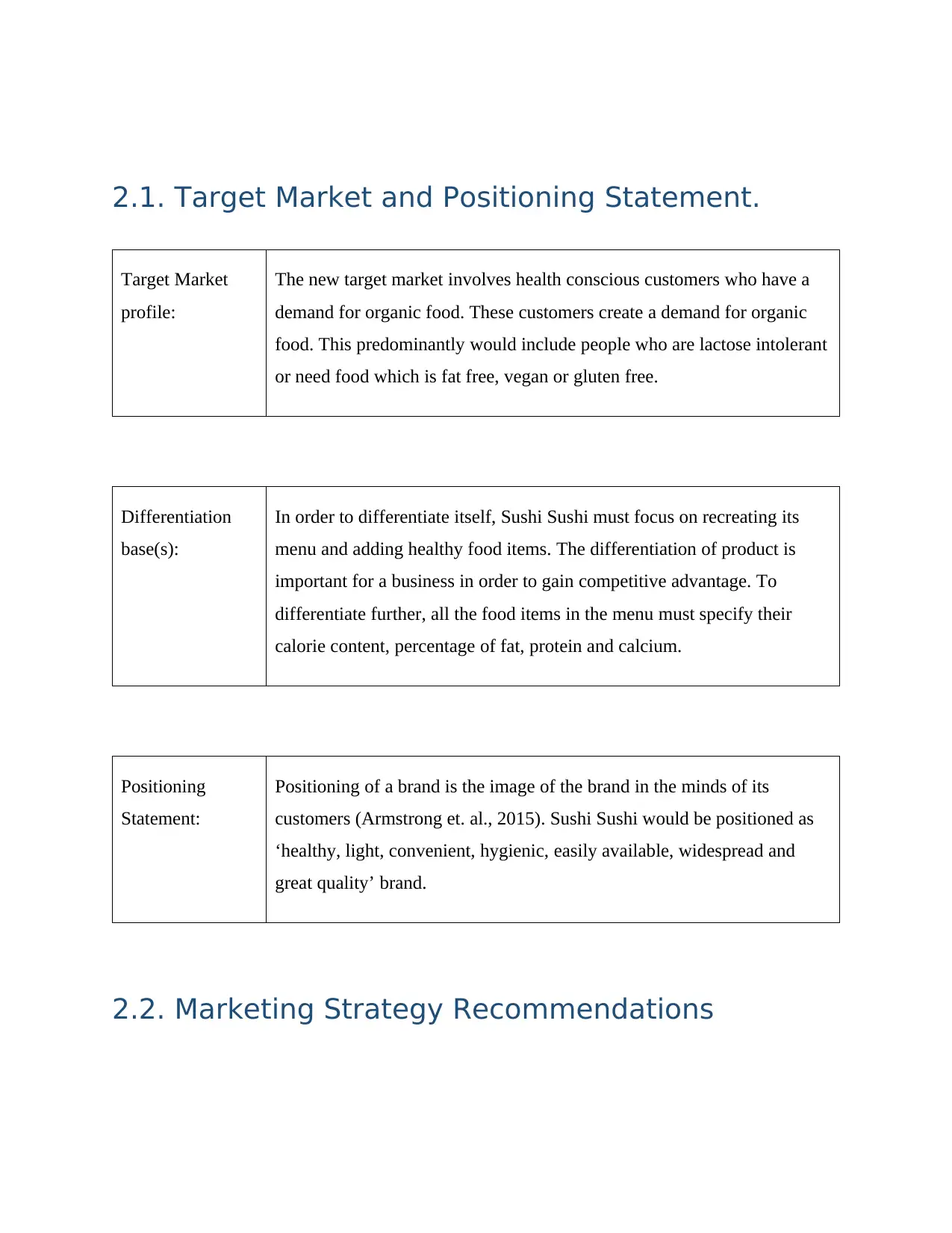
2.1. Target Market and Positioning Statement.
Target Market
profile:
The new target market involves health conscious customers who have a
demand for organic food. These customers create a demand for organic
food. This predominantly would include people who are lactose intolerant
or need food which is fat free, vegan or gluten free.
Differentiation
base(s):
In order to differentiate itself, Sushi Sushi must focus on recreating its
menu and adding healthy food items. The differentiation of product is
important for a business in order to gain competitive advantage. To
differentiate further, all the food items in the menu must specify their
calorie content, percentage of fat, protein and calcium.
Positioning
Statement:
Positioning of a brand is the image of the brand in the minds of its
customers (Armstrong et. al., 2015). Sushi Sushi would be positioned as
‘healthy, light, convenient, hygienic, easily available, widespread and
great quality’ brand.
2.2. Marketing Strategy Recommendations
Target Market
profile:
The new target market involves health conscious customers who have a
demand for organic food. These customers create a demand for organic
food. This predominantly would include people who are lactose intolerant
or need food which is fat free, vegan or gluten free.
Differentiation
base(s):
In order to differentiate itself, Sushi Sushi must focus on recreating its
menu and adding healthy food items. The differentiation of product is
important for a business in order to gain competitive advantage. To
differentiate further, all the food items in the menu must specify their
calorie content, percentage of fat, protein and calcium.
Positioning
Statement:
Positioning of a brand is the image of the brand in the minds of its
customers (Armstrong et. al., 2015). Sushi Sushi would be positioned as
‘healthy, light, convenient, hygienic, easily available, widespread and
great quality’ brand.
2.2. Marketing Strategy Recommendations
⊘ This is a preview!⊘
Do you want full access?
Subscribe today to unlock all pages.

Trusted by 1+ million students worldwide
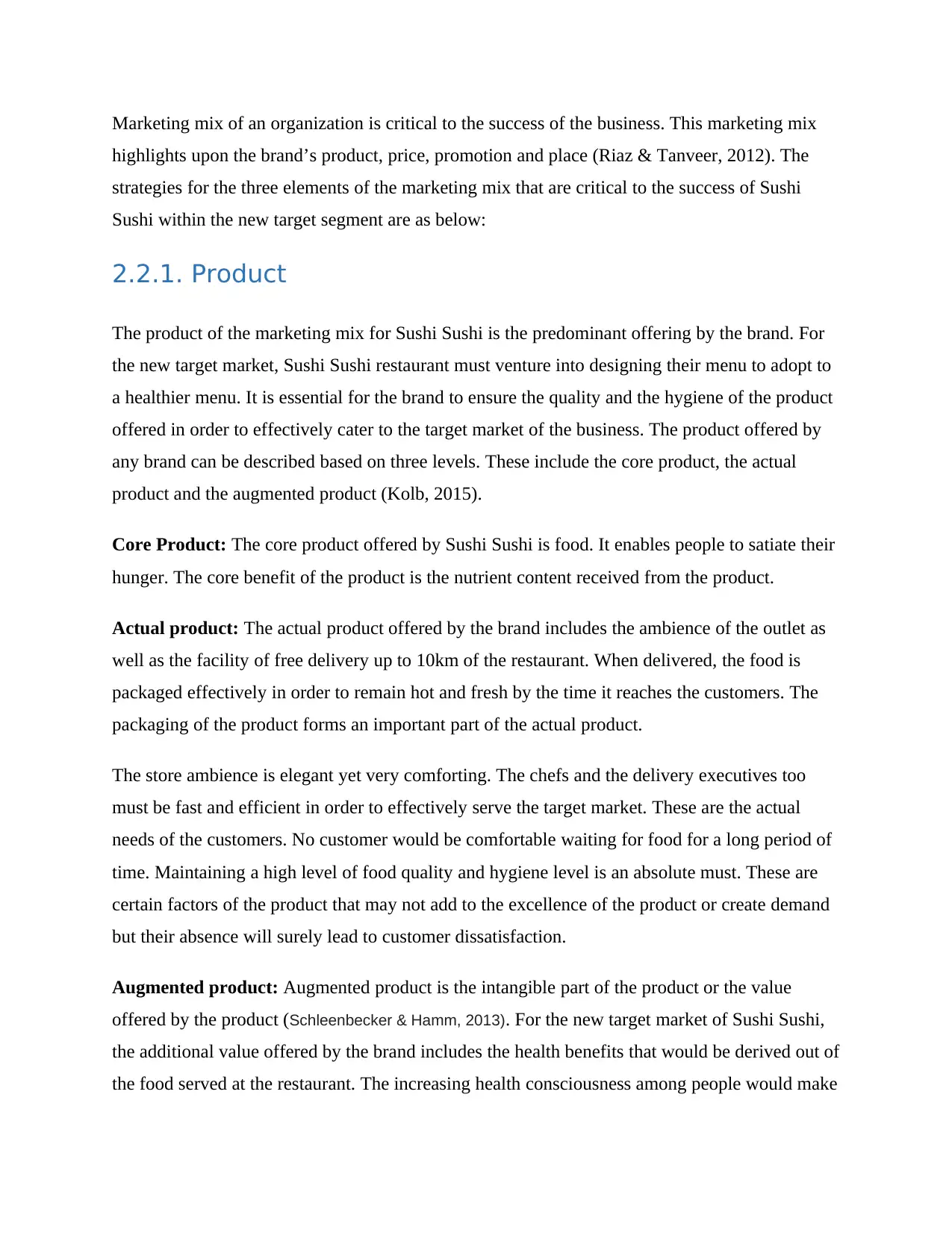
Marketing mix of an organization is critical to the success of the business. This marketing mix
highlights upon the brand’s product, price, promotion and place (Riaz & Tanveer, 2012). The
strategies for the three elements of the marketing mix that are critical to the success of Sushi
Sushi within the new target segment are as below:
2.2.1. Product
The product of the marketing mix for Sushi Sushi is the predominant offering by the brand. For
the new target market, Sushi Sushi restaurant must venture into designing their menu to adopt to
a healthier menu. It is essential for the brand to ensure the quality and the hygiene of the product
offered in order to effectively cater to the target market of the business. The product offered by
any brand can be described based on three levels. These include the core product, the actual
product and the augmented product (Kolb, 2015).
Core Product: The core product offered by Sushi Sushi is food. It enables people to satiate their
hunger. The core benefit of the product is the nutrient content received from the product.
Actual product: The actual product offered by the brand includes the ambience of the outlet as
well as the facility of free delivery up to 10km of the restaurant. When delivered, the food is
packaged effectively in order to remain hot and fresh by the time it reaches the customers. The
packaging of the product forms an important part of the actual product.
The store ambience is elegant yet very comforting. The chefs and the delivery executives too
must be fast and efficient in order to effectively serve the target market. These are the actual
needs of the customers. No customer would be comfortable waiting for food for a long period of
time. Maintaining a high level of food quality and hygiene level is an absolute must. These are
certain factors of the product that may not add to the excellence of the product or create demand
but their absence will surely lead to customer dissatisfaction.
Augmented product: Augmented product is the intangible part of the product or the value
offered by the product (Schleenbecker & Hamm, 2013). For the new target market of Sushi Sushi,
the additional value offered by the brand includes the health benefits that would be derived out of
the food served at the restaurant. The increasing health consciousness among people would make
highlights upon the brand’s product, price, promotion and place (Riaz & Tanveer, 2012). The
strategies for the three elements of the marketing mix that are critical to the success of Sushi
Sushi within the new target segment are as below:
2.2.1. Product
The product of the marketing mix for Sushi Sushi is the predominant offering by the brand. For
the new target market, Sushi Sushi restaurant must venture into designing their menu to adopt to
a healthier menu. It is essential for the brand to ensure the quality and the hygiene of the product
offered in order to effectively cater to the target market of the business. The product offered by
any brand can be described based on three levels. These include the core product, the actual
product and the augmented product (Kolb, 2015).
Core Product: The core product offered by Sushi Sushi is food. It enables people to satiate their
hunger. The core benefit of the product is the nutrient content received from the product.
Actual product: The actual product offered by the brand includes the ambience of the outlet as
well as the facility of free delivery up to 10km of the restaurant. When delivered, the food is
packaged effectively in order to remain hot and fresh by the time it reaches the customers. The
packaging of the product forms an important part of the actual product.
The store ambience is elegant yet very comforting. The chefs and the delivery executives too
must be fast and efficient in order to effectively serve the target market. These are the actual
needs of the customers. No customer would be comfortable waiting for food for a long period of
time. Maintaining a high level of food quality and hygiene level is an absolute must. These are
certain factors of the product that may not add to the excellence of the product or create demand
but their absence will surely lead to customer dissatisfaction.
Augmented product: Augmented product is the intangible part of the product or the value
offered by the product (Schleenbecker & Hamm, 2013). For the new target market of Sushi Sushi,
the additional value offered by the brand includes the health benefits that would be derived out of
the food served at the restaurant. The increasing health consciousness among people would make
Paraphrase This Document
Need a fresh take? Get an instant paraphrase of this document with our AI Paraphraser
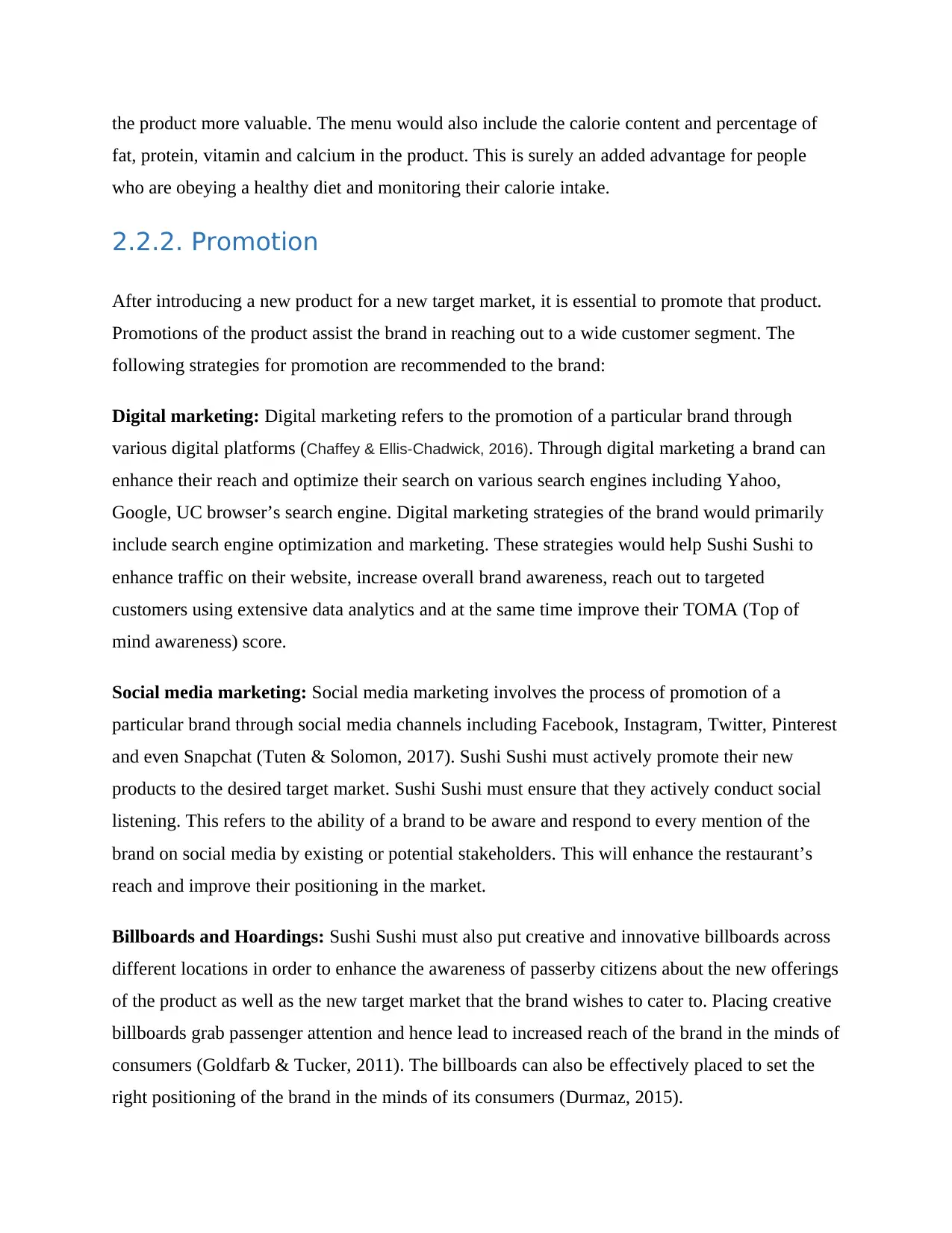
the product more valuable. The menu would also include the calorie content and percentage of
fat, protein, vitamin and calcium in the product. This is surely an added advantage for people
who are obeying a healthy diet and monitoring their calorie intake.
2.2.2. Promotion
After introducing a new product for a new target market, it is essential to promote that product.
Promotions of the product assist the brand in reaching out to a wide customer segment. The
following strategies for promotion are recommended to the brand:
Digital marketing: Digital marketing refers to the promotion of a particular brand through
various digital platforms (Chaffey & Ellis-Chadwick, 2016). Through digital marketing a brand can
enhance their reach and optimize their search on various search engines including Yahoo,
Google, UC browser’s search engine. Digital marketing strategies of the brand would primarily
include search engine optimization and marketing. These strategies would help Sushi Sushi to
enhance traffic on their website, increase overall brand awareness, reach out to targeted
customers using extensive data analytics and at the same time improve their TOMA (Top of
mind awareness) score.
Social media marketing: Social media marketing involves the process of promotion of a
particular brand through social media channels including Facebook, Instagram, Twitter, Pinterest
and even Snapchat (Tuten & Solomon, 2017). Sushi Sushi must actively promote their new
products to the desired target market. Sushi Sushi must ensure that they actively conduct social
listening. This refers to the ability of a brand to be aware and respond to every mention of the
brand on social media by existing or potential stakeholders. This will enhance the restaurant’s
reach and improve their positioning in the market.
Billboards and Hoardings: Sushi Sushi must also put creative and innovative billboards across
different locations in order to enhance the awareness of passerby citizens about the new offerings
of the product as well as the new target market that the brand wishes to cater to. Placing creative
billboards grab passenger attention and hence lead to increased reach of the brand in the minds of
consumers (Goldfarb & Tucker, 2011). The billboards can also be effectively placed to set the
right positioning of the brand in the minds of its consumers (Durmaz, 2015).
fat, protein, vitamin and calcium in the product. This is surely an added advantage for people
who are obeying a healthy diet and monitoring their calorie intake.
2.2.2. Promotion
After introducing a new product for a new target market, it is essential to promote that product.
Promotions of the product assist the brand in reaching out to a wide customer segment. The
following strategies for promotion are recommended to the brand:
Digital marketing: Digital marketing refers to the promotion of a particular brand through
various digital platforms (Chaffey & Ellis-Chadwick, 2016). Through digital marketing a brand can
enhance their reach and optimize their search on various search engines including Yahoo,
Google, UC browser’s search engine. Digital marketing strategies of the brand would primarily
include search engine optimization and marketing. These strategies would help Sushi Sushi to
enhance traffic on their website, increase overall brand awareness, reach out to targeted
customers using extensive data analytics and at the same time improve their TOMA (Top of
mind awareness) score.
Social media marketing: Social media marketing involves the process of promotion of a
particular brand through social media channels including Facebook, Instagram, Twitter, Pinterest
and even Snapchat (Tuten & Solomon, 2017). Sushi Sushi must actively promote their new
products to the desired target market. Sushi Sushi must ensure that they actively conduct social
listening. This refers to the ability of a brand to be aware and respond to every mention of the
brand on social media by existing or potential stakeholders. This will enhance the restaurant’s
reach and improve their positioning in the market.
Billboards and Hoardings: Sushi Sushi must also put creative and innovative billboards across
different locations in order to enhance the awareness of passerby citizens about the new offerings
of the product as well as the new target market that the brand wishes to cater to. Placing creative
billboards grab passenger attention and hence lead to increased reach of the brand in the minds of
consumers (Goldfarb & Tucker, 2011). The billboards can also be effectively placed to set the
right positioning of the brand in the minds of its consumers (Durmaz, 2015).
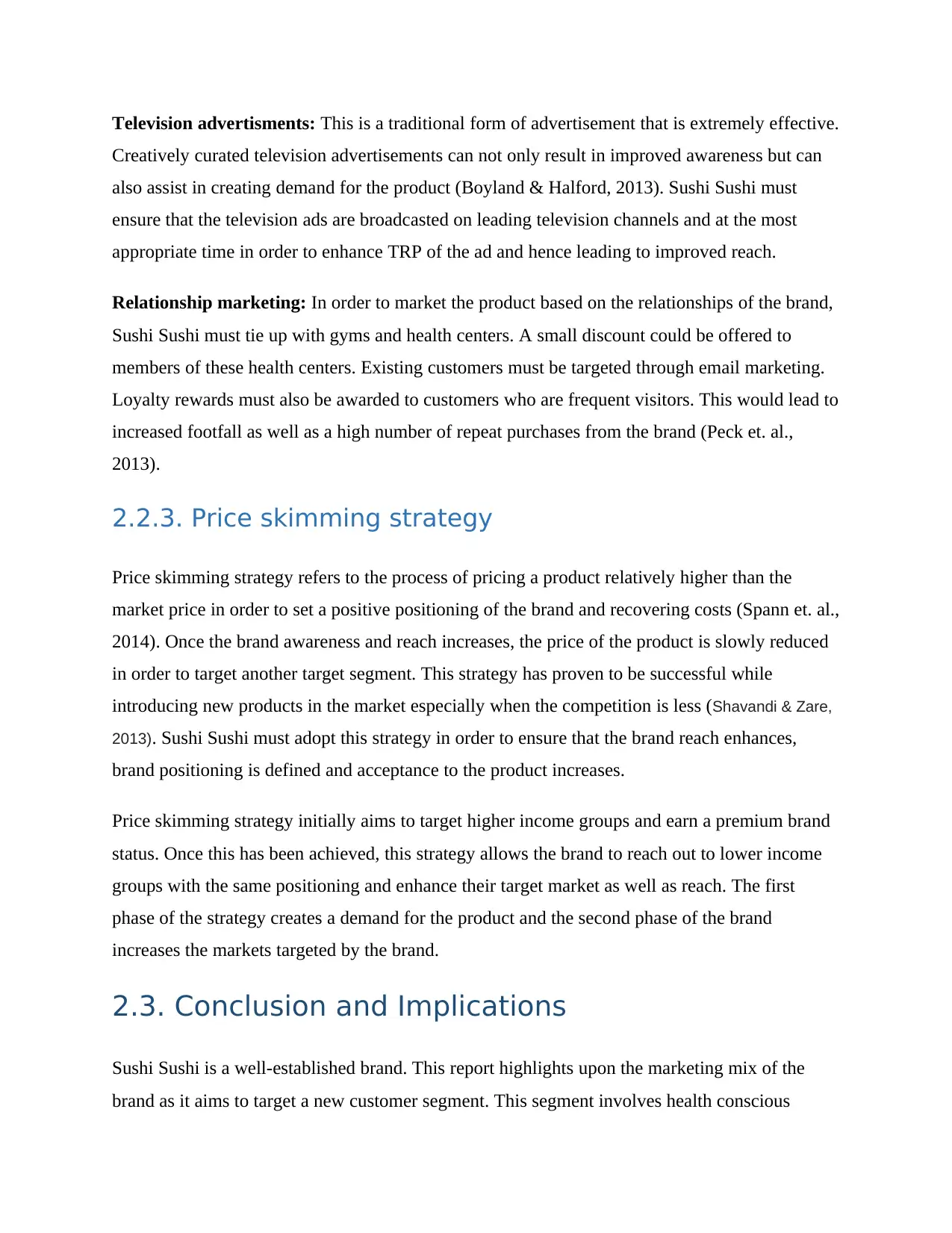
Television advertisments: This is a traditional form of advertisement that is extremely effective.
Creatively curated television advertisements can not only result in improved awareness but can
also assist in creating demand for the product (Boyland & Halford, 2013). Sushi Sushi must
ensure that the television ads are broadcasted on leading television channels and at the most
appropriate time in order to enhance TRP of the ad and hence leading to improved reach.
Relationship marketing: In order to market the product based on the relationships of the brand,
Sushi Sushi must tie up with gyms and health centers. A small discount could be offered to
members of these health centers. Existing customers must be targeted through email marketing.
Loyalty rewards must also be awarded to customers who are frequent visitors. This would lead to
increased footfall as well as a high number of repeat purchases from the brand (Peck et. al.,
2013).
2.2.3. Price skimming strategy
Price skimming strategy refers to the process of pricing a product relatively higher than the
market price in order to set a positive positioning of the brand and recovering costs (Spann et. al.,
2014). Once the brand awareness and reach increases, the price of the product is slowly reduced
in order to target another target segment. This strategy has proven to be successful while
introducing new products in the market especially when the competition is less (Shavandi & Zare,
2013). Sushi Sushi must adopt this strategy in order to ensure that the brand reach enhances,
brand positioning is defined and acceptance to the product increases.
Price skimming strategy initially aims to target higher income groups and earn a premium brand
status. Once this has been achieved, this strategy allows the brand to reach out to lower income
groups with the same positioning and enhance their target market as well as reach. The first
phase of the strategy creates a demand for the product and the second phase of the brand
increases the markets targeted by the brand.
2.3. Conclusion and Implications
Sushi Sushi is a well-established brand. This report highlights upon the marketing mix of the
brand as it aims to target a new customer segment. This segment involves health conscious
Creatively curated television advertisements can not only result in improved awareness but can
also assist in creating demand for the product (Boyland & Halford, 2013). Sushi Sushi must
ensure that the television ads are broadcasted on leading television channels and at the most
appropriate time in order to enhance TRP of the ad and hence leading to improved reach.
Relationship marketing: In order to market the product based on the relationships of the brand,
Sushi Sushi must tie up with gyms and health centers. A small discount could be offered to
members of these health centers. Existing customers must be targeted through email marketing.
Loyalty rewards must also be awarded to customers who are frequent visitors. This would lead to
increased footfall as well as a high number of repeat purchases from the brand (Peck et. al.,
2013).
2.2.3. Price skimming strategy
Price skimming strategy refers to the process of pricing a product relatively higher than the
market price in order to set a positive positioning of the brand and recovering costs (Spann et. al.,
2014). Once the brand awareness and reach increases, the price of the product is slowly reduced
in order to target another target segment. This strategy has proven to be successful while
introducing new products in the market especially when the competition is less (Shavandi & Zare,
2013). Sushi Sushi must adopt this strategy in order to ensure that the brand reach enhances,
brand positioning is defined and acceptance to the product increases.
Price skimming strategy initially aims to target higher income groups and earn a premium brand
status. Once this has been achieved, this strategy allows the brand to reach out to lower income
groups with the same positioning and enhance their target market as well as reach. The first
phase of the strategy creates a demand for the product and the second phase of the brand
increases the markets targeted by the brand.
2.3. Conclusion and Implications
Sushi Sushi is a well-established brand. This report highlights upon the marketing mix of the
brand as it aims to target a new customer segment. This segment involves health conscious
⊘ This is a preview!⊘
Do you want full access?
Subscribe today to unlock all pages.

Trusted by 1+ million students worldwide
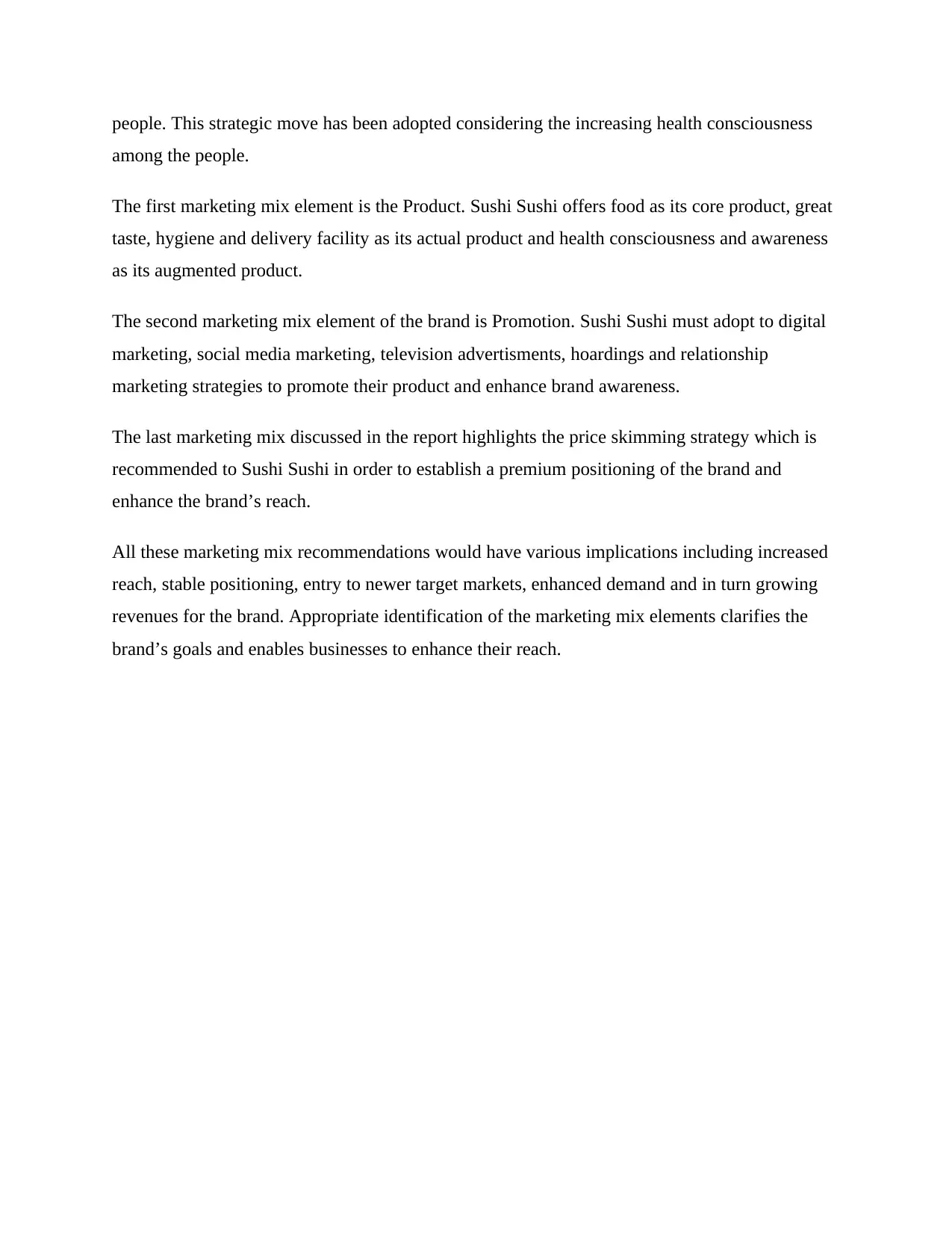
people. This strategic move has been adopted considering the increasing health consciousness
among the people.
The first marketing mix element is the Product. Sushi Sushi offers food as its core product, great
taste, hygiene and delivery facility as its actual product and health consciousness and awareness
as its augmented product.
The second marketing mix element of the brand is Promotion. Sushi Sushi must adopt to digital
marketing, social media marketing, television advertisments, hoardings and relationship
marketing strategies to promote their product and enhance brand awareness.
The last marketing mix discussed in the report highlights the price skimming strategy which is
recommended to Sushi Sushi in order to establish a premium positioning of the brand and
enhance the brand’s reach.
All these marketing mix recommendations would have various implications including increased
reach, stable positioning, entry to newer target markets, enhanced demand and in turn growing
revenues for the brand. Appropriate identification of the marketing mix elements clarifies the
brand’s goals and enables businesses to enhance their reach.
among the people.
The first marketing mix element is the Product. Sushi Sushi offers food as its core product, great
taste, hygiene and delivery facility as its actual product and health consciousness and awareness
as its augmented product.
The second marketing mix element of the brand is Promotion. Sushi Sushi must adopt to digital
marketing, social media marketing, television advertisments, hoardings and relationship
marketing strategies to promote their product and enhance brand awareness.
The last marketing mix discussed in the report highlights the price skimming strategy which is
recommended to Sushi Sushi in order to establish a premium positioning of the brand and
enhance the brand’s reach.
All these marketing mix recommendations would have various implications including increased
reach, stable positioning, entry to newer target markets, enhanced demand and in turn growing
revenues for the brand. Appropriate identification of the marketing mix elements clarifies the
brand’s goals and enables businesses to enhance their reach.
Paraphrase This Document
Need a fresh take? Get an instant paraphrase of this document with our AI Paraphraser
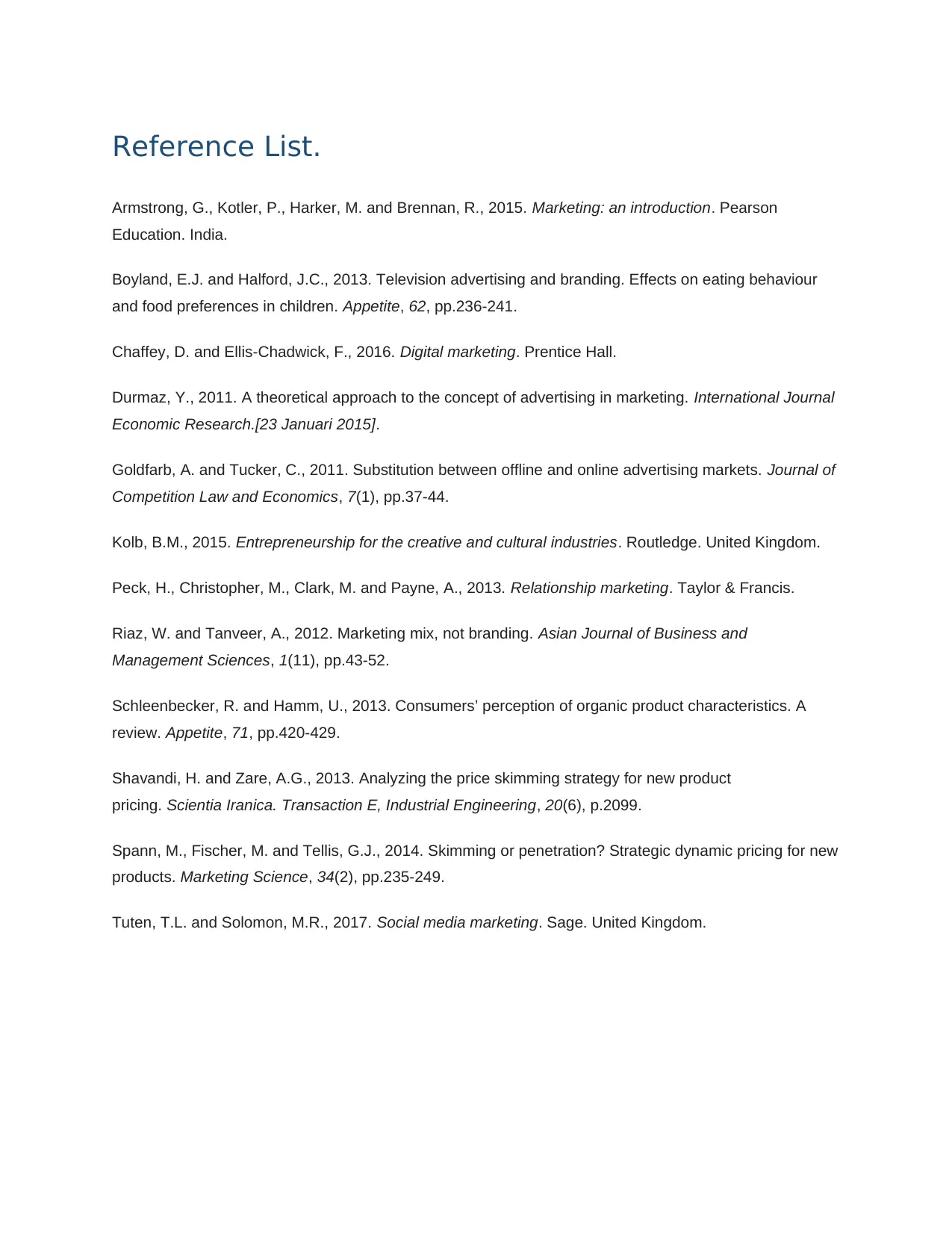
Reference List.
Armstrong, G., Kotler, P., Harker, M. and Brennan, R., 2015. Marketing: an introduction. Pearson
Education. India.
Boyland, E.J. and Halford, J.C., 2013. Television advertising and branding. Effects on eating behaviour
and food preferences in children. Appetite, 62, pp.236-241.
Chaffey, D. and Ellis-Chadwick, F., 2016. Digital marketing. Prentice Hall.
Durmaz, Y., 2011. A theoretical approach to the concept of advertising in marketing. International Journal
Economic Research.[23 Januari 2015].
Goldfarb, A. and Tucker, C., 2011. Substitution between offline and online advertising markets. Journal of
Competition Law and Economics, 7(1), pp.37-44.
Kolb, B.M., 2015. Entrepreneurship for the creative and cultural industries. Routledge. United Kingdom.
Peck, H., Christopher, M., Clark, M. and Payne, A., 2013. Relationship marketing. Taylor & Francis.
Riaz, W. and Tanveer, A., 2012. Marketing mix, not branding. Asian Journal of Business and
Management Sciences, 1(11), pp.43-52.
Schleenbecker, R. and Hamm, U., 2013. Consumers’ perception of organic product characteristics. A
review. Appetite, 71, pp.420-429.
Shavandi, H. and Zare, A.G., 2013. Analyzing the price skimming strategy for new product
pricing. Scientia Iranica. Transaction E, Industrial Engineering, 20(6), p.2099.
Spann, M., Fischer, M. and Tellis, G.J., 2014. Skimming or penetration? Strategic dynamic pricing for new
products. Marketing Science, 34(2), pp.235-249.
Tuten, T.L. and Solomon, M.R., 2017. Social media marketing. Sage. United Kingdom.
Armstrong, G., Kotler, P., Harker, M. and Brennan, R., 2015. Marketing: an introduction. Pearson
Education. India.
Boyland, E.J. and Halford, J.C., 2013. Television advertising and branding. Effects on eating behaviour
and food preferences in children. Appetite, 62, pp.236-241.
Chaffey, D. and Ellis-Chadwick, F., 2016. Digital marketing. Prentice Hall.
Durmaz, Y., 2011. A theoretical approach to the concept of advertising in marketing. International Journal
Economic Research.[23 Januari 2015].
Goldfarb, A. and Tucker, C., 2011. Substitution between offline and online advertising markets. Journal of
Competition Law and Economics, 7(1), pp.37-44.
Kolb, B.M., 2015. Entrepreneurship for the creative and cultural industries. Routledge. United Kingdom.
Peck, H., Christopher, M., Clark, M. and Payne, A., 2013. Relationship marketing. Taylor & Francis.
Riaz, W. and Tanveer, A., 2012. Marketing mix, not branding. Asian Journal of Business and
Management Sciences, 1(11), pp.43-52.
Schleenbecker, R. and Hamm, U., 2013. Consumers’ perception of organic product characteristics. A
review. Appetite, 71, pp.420-429.
Shavandi, H. and Zare, A.G., 2013. Analyzing the price skimming strategy for new product
pricing. Scientia Iranica. Transaction E, Industrial Engineering, 20(6), p.2099.
Spann, M., Fischer, M. and Tellis, G.J., 2014. Skimming or penetration? Strategic dynamic pricing for new
products. Marketing Science, 34(2), pp.235-249.
Tuten, T.L. and Solomon, M.R., 2017. Social media marketing. Sage. United Kingdom.
1 out of 8
Related Documents
Your All-in-One AI-Powered Toolkit for Academic Success.
+13062052269
info@desklib.com
Available 24*7 on WhatsApp / Email
![[object Object]](/_next/static/media/star-bottom.7253800d.svg)
Unlock your academic potential
Copyright © 2020–2025 A2Z Services. All Rights Reserved. Developed and managed by ZUCOL.




